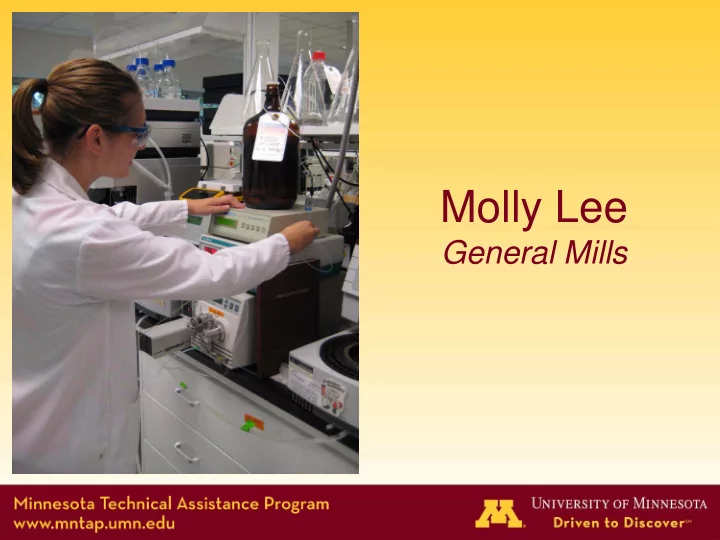

Molly Lee General Mills
Solvent Recovery and Reuse General Mills, Inc. Molly Lee Advisor: Jeff Becker
General Mills, Inc. • Sixth largest global food company • Hazardous waste produced by analytical laboratories testing for food quality and safety
Motivation for Change
Reasons for MnTAP Assistance • Process reduction – Hazardous waste generation – Virgin solvent use – Raw material and waste disposal costs • Maintain small quantity generator size while enabling the lab to grow • Increase safety and sustainability • Strengthen relationship with the U of M • Utilize technical support from MnTAP resources
Approach • Analyzed waste stream • Learned all processes records from the past year contributing to waste drums by discussing Wet Chemistry Waste Drum solvent use with each 350 100.00% of the lab analysts 90.00% 300 80.00% 250 70.00% 60.00% 200 50.00% 150 40.00% 30.00% 100 20.00% 50 10.00% 0 0.00% Quantity (L) Count %
Determining Inefficient Processes • Identified and quantified contaminants in each of the individual waste streams • Identified processes with least contaminants and Diatom Starch easiest separations • Received input from vendors, analysts, outside sources
Solvent Recovery Overview One Size Fits All Customized • The largest streams • Customized purification are all addressed by methods for each waste one single purification stream method Solvent 2 Solvent 1 Solvent 3 Solvent 1 Solvent 2 Solvent 3 Distill Desiccate Divert Filter
One Size Fits All: Distillation • Largest streams could Vapor Liquid Equilibrium of Acetonitrile/Water Mixture be collected separately and stored daily in each laboratory • Separate materials based on volatility of components in mixture Pure • Challenges: Acetone -Azeotropes J. Phys. Chem. , 1956 , 60 (8), pp 1146–1147 Acetone Water Water Azeotrope Composition Fats -Safety, Space Fats Dyes Dyes
Recommended Process Change • Implement a distillation unit able to distill acetonitrile/water, acetone, heptanes, and methanol waste streams, distilling one per day Total savings/year $15,500 Total pounds/year saved 2,250 Percent of flammable waste 32% Return on investment 1.25 years B/R Instrument Corporation, 9600 Recycling System
Customized Approach 1: Recover Clean Mobile Phase • 185 gallons/year of acetonitrile/water used as the mobile Column Injector Detector phase for one HPLC assay • Utilizes separation Pump from HPLC column • Clean solvent is sent back to mobile phase • Distill waste for reuse Clean Mobile Waste Phase
Successful Process Change • Installed a Solvent Trak clean solvent diverting unit for one of the HPLC systems Waste Recycle Total savings/year $3,600 Could apply to 4 other Total pounds/year saved 290 HPLC systems at JFB and 5-10 sugars systems Percent of flammable waste 5% at manufacturing plants Return on Investment 6 months
Customized Approach 2: Acetone Recycle • Wet chemistry analysis uses an estimated 85 gallons/year Acetone of acetone as a final rinse of Water Fats, Dyes, one of the processes Starches • The waste stream contains small amounts of dyes, Membrane starches, fats, and water Acetone Water • Use filtration to remove contaminants
Recommended Process Change • Implement a nanofiltration system to purify the acetone waste stream through a ceramic membrane for reuse in the same process Total savings/year $2,800 Total pounds/year saved 660 Percent of flammable waste 10% Return on Investment (est.) 6 months Water in recycled stream Solution: desiccate, distill, or reuse for limited time
Personal Benefits • Project management experience • Direct chemical engineering and chemistry concepts able to be applied and practiced • Pollution, environmental impact, and safety models learned • Networking • Customer relation experience with analytical laboratory
Thank You • All analysts at General Mills who provided information, answered questions, and collected separate waste streams • Vendors and other outside sources • Special thanks to: General Mills: Carolyn Sampson, Brett Post, Brooke Vetter, Paul Gould, Tim Peters MnTAP: Jeff Becker, Krysta Larson Vendors: ChromTech, NexGen Envirosystems, B/R Instruments Corporation
Recommend
More recommend